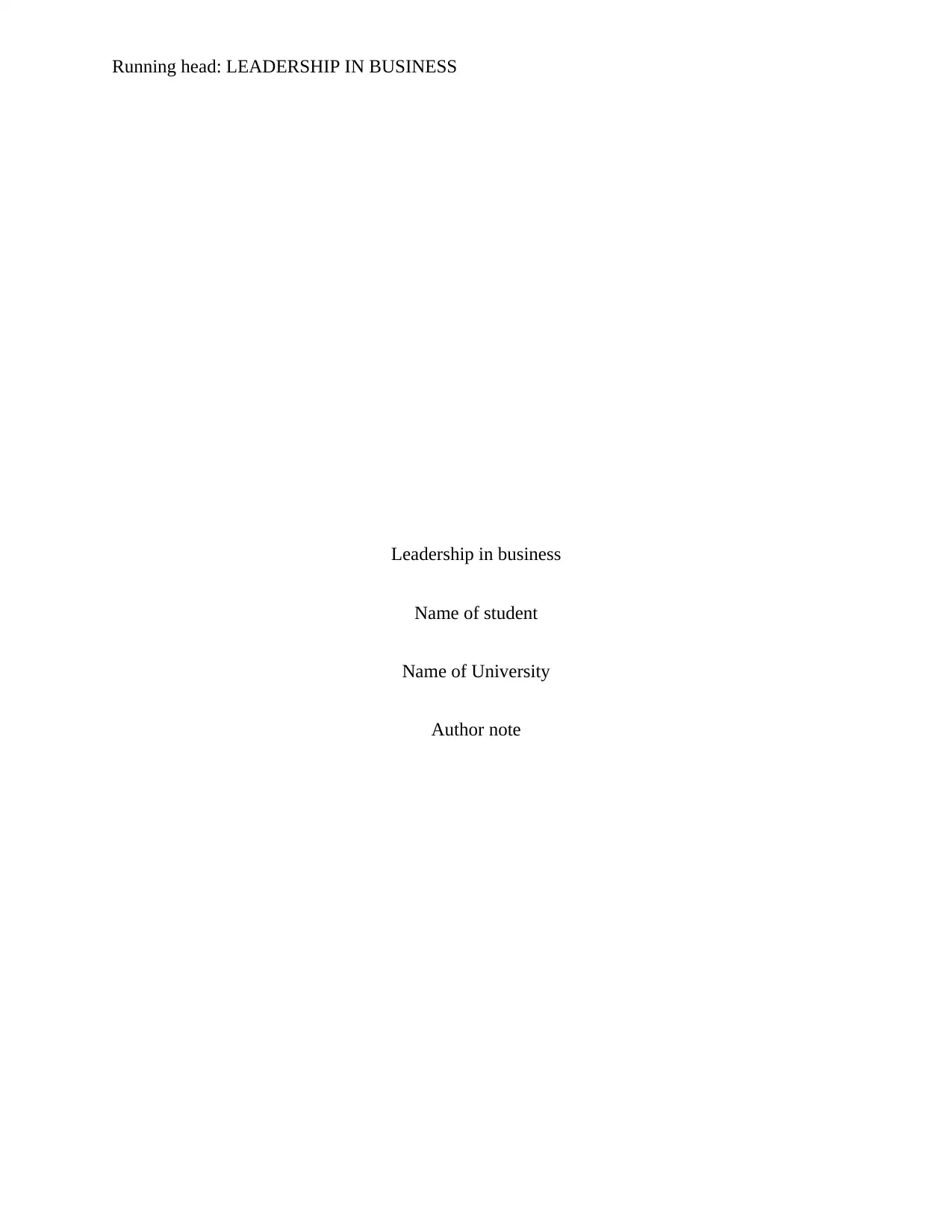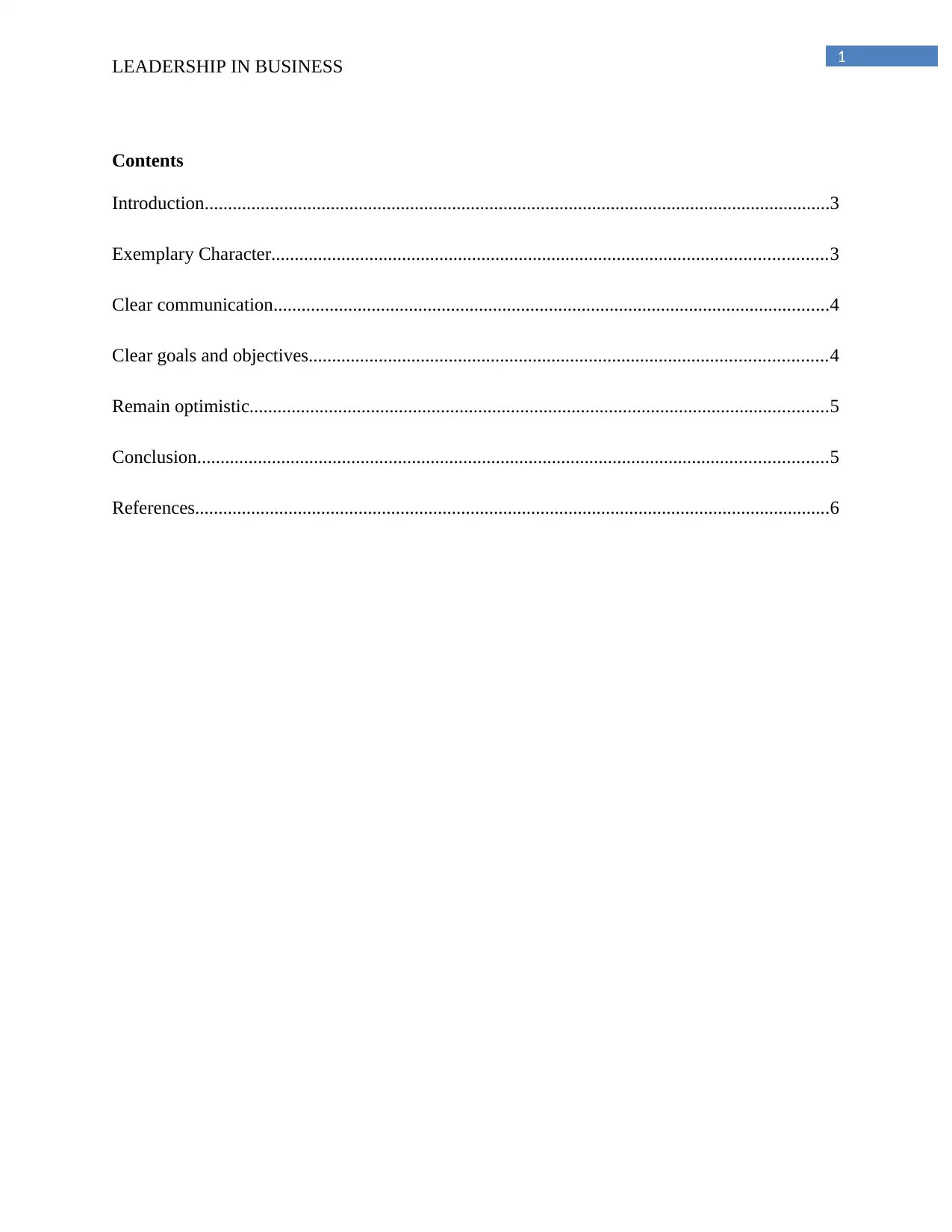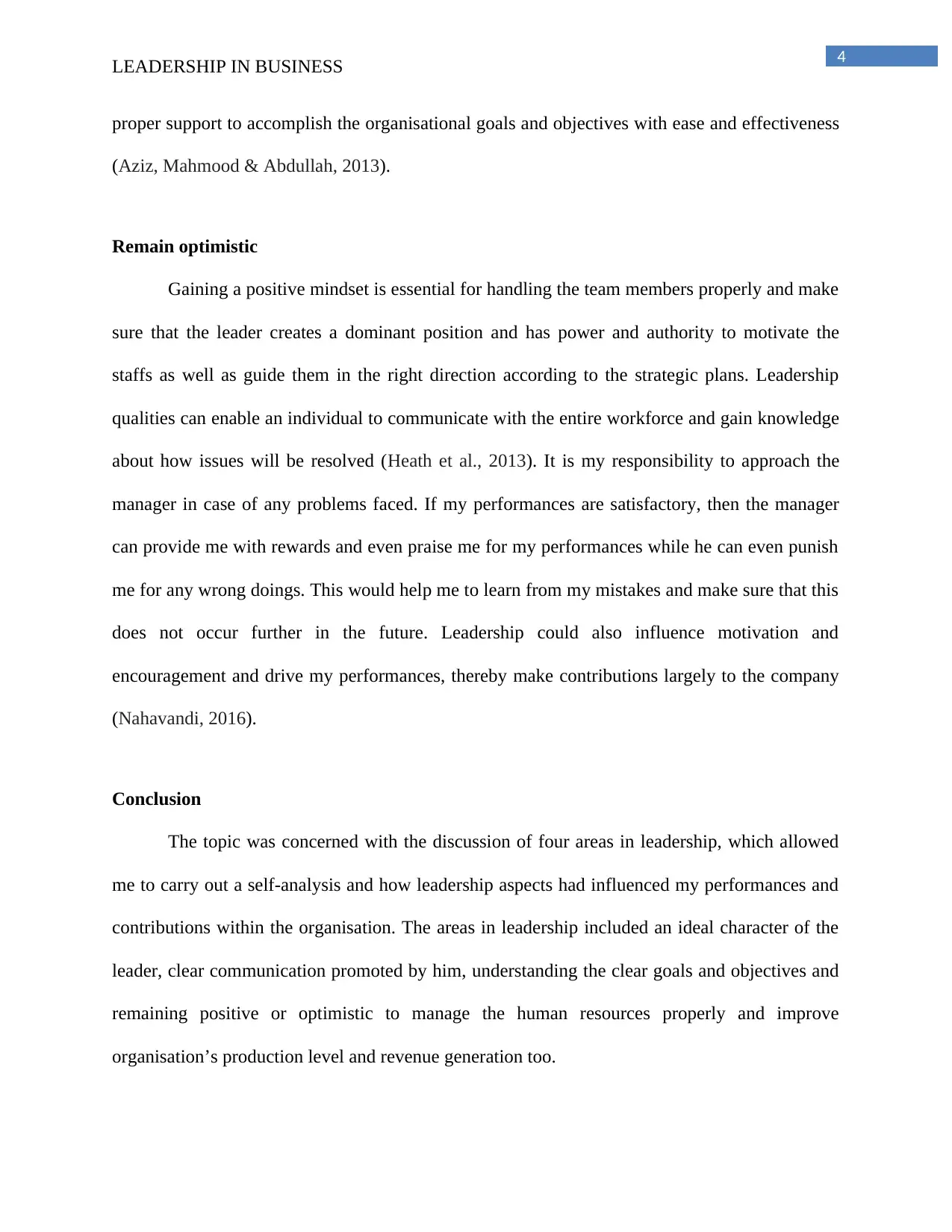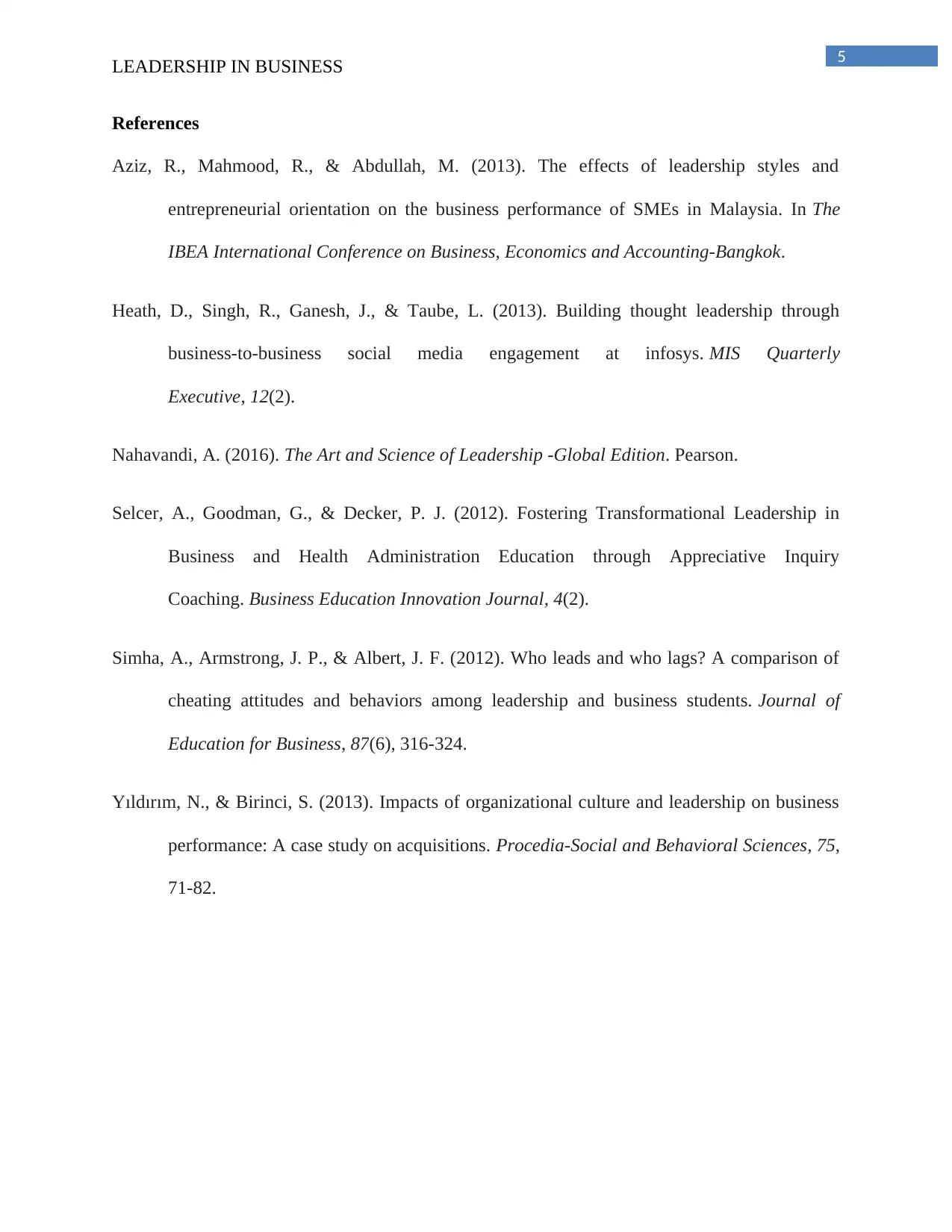Leadership in Business: Qualities, Communication, and Impact
VerifiedAdded on 2020/03/01
|6
|1187
|53
Report
AI Summary
This report analyzes key leadership qualities and their impact on business performance, based on a student's observations. It covers the importance of exemplary character, emphasizing the leader's understanding of their role and the need for ethical behavior and trust-building with employees. The report also highlights the significance of clear communication to foster open dialogue, address issues, and align the team with organizational goals. Furthermore, it underscores the role of leaders in setting clear goals and objectives, ensuring employees understand their responsibilities and contribute effectively. Lastly, it discusses the need for leaders to remain optimistic and motivate the workforce to drive performance and achieve strategic plans. The student's personal experiences and observations are used to illustrate these leadership aspects.

Running head: LEADERSHIP IN BUSINESS
Leadership in business
Name of student
Name of University
Author note
Leadership in business
Name of student
Name of University
Author note
Paraphrase This Document
Need a fresh take? Get an instant paraphrase of this document with our AI Paraphraser

1
LEADERSHIP IN BUSINESS
Contents
Introduction......................................................................................................................................3
Exemplary Character.......................................................................................................................3
Clear communication.......................................................................................................................4
Clear goals and objectives...............................................................................................................4
Remain optimistic............................................................................................................................5
Conclusion.......................................................................................................................................5
References........................................................................................................................................6
LEADERSHIP IN BUSINESS
Contents
Introduction......................................................................................................................................3
Exemplary Character.......................................................................................................................3
Clear communication.......................................................................................................................4
Clear goals and objectives...............................................................................................................4
Remain optimistic............................................................................................................................5
Conclusion.......................................................................................................................................5
References........................................................................................................................................6

2
LEADERSHIP IN BUSINESS
Introduction
The topic discusses the major areas in leadership and impact of leadership on the
employee and organisational performance positively. With the vast number of employees
appointed along with the need of enhanced work performance by skilled individuals, there is
need of proper leadership to fulfill the needs and preferences of staffs and guide them in the right
direction to accomplish the organisational goals and objectives with ease and effectiveness. The
leaders in business must adopt various leadership qualities and behaviours to manage the
workforce consisting of employees properly and gain the trust and loyalty of employees too by
influencing their behaviour and make them perform to their potential (Aziz, Mahmood &
Abdullah, 2013).
Exemplary Character
By studying the various areas in leadership, I have understood that a leader shall have
good skills and knowledge and have a clear understanding of who he is and how can he
contribute to the organisational efficiency. There are many followers of the leader, and thus a
leader must possess a good understanding and gain the trust of employees by listening to their
opinions properly and motivate them too (Heath et al., 2013). The leaders must have good values
and ethics to deal with critical situations by making the followers understand about how bad
habits like smoking or drinking in the organisational premises, bad behaviours, etc. can be
avoided. While working with the leader, I have watched closely that though the leader engages
with the team members, still he enjoys every situation in a controlled way and makes sure that he
does not misbehave or conduct wrong doings that can discourage the staff member or even
damage the reputation of the company and himself as well (Nahavandi, 2016).
LEADERSHIP IN BUSINESS
Introduction
The topic discusses the major areas in leadership and impact of leadership on the
employee and organisational performance positively. With the vast number of employees
appointed along with the need of enhanced work performance by skilled individuals, there is
need of proper leadership to fulfill the needs and preferences of staffs and guide them in the right
direction to accomplish the organisational goals and objectives with ease and effectiveness. The
leaders in business must adopt various leadership qualities and behaviours to manage the
workforce consisting of employees properly and gain the trust and loyalty of employees too by
influencing their behaviour and make them perform to their potential (Aziz, Mahmood &
Abdullah, 2013).
Exemplary Character
By studying the various areas in leadership, I have understood that a leader shall have
good skills and knowledge and have a clear understanding of who he is and how can he
contribute to the organisational efficiency. There are many followers of the leader, and thus a
leader must possess a good understanding and gain the trust of employees by listening to their
opinions properly and motivate them too (Heath et al., 2013). The leaders must have good values
and ethics to deal with critical situations by making the followers understand about how bad
habits like smoking or drinking in the organisational premises, bad behaviours, etc. can be
avoided. While working with the leader, I have watched closely that though the leader engages
with the team members, still he enjoys every situation in a controlled way and makes sure that he
does not misbehave or conduct wrong doings that can discourage the staff member or even
damage the reputation of the company and himself as well (Nahavandi, 2016).
⊘ This is a preview!⊘
Do you want full access?
Subscribe today to unlock all pages.

Trusted by 1+ million students worldwide

3
LEADERSHIP IN BUSINESS
Clear communication
Another major area of leadership is to promote open communication and allow team
members and staffs to interact with each other to discuss the problems and understand the vision
and mission statement before the achievement of organisational goals and objectives. My leader
has made me understood the importance of communication, and so I have interacted with the
team members and staffs to discuss the problems and find out ways to improve my performances
and contribute to the organisational effectiveness (Selcer, Goodman & Decker, 2012). Lack of
communication can often lead to misunderstanding, poor ability to solve problems and make
decisions effectively. Clear communication promoted by leaders can also help leaders to obtain
the ideas and opinions of employees and make a good decision in the end for the benefit of the
organisation. By promoting clear communication, the leader has also created a positive
organizational culture within the workplace (Simha, Armstrong & Albert, 2012).
Clear goals and objectives
The leadership qualities present within the person help in guiding the employees in the
right direction as well as understand the goals and objectives properly that are needed to be
achieved. It is the first and foremost thing that is needed to be considered by the leader before
establishing communication with the staffs and makes them understand their roles and
responsibilities. By obtaining knowledge about the goals and objectives that are needed to be
achieved, I have managed to communicate with the leader and discussed the matter and even
provided my ideas and thinking that can benefit the organisation as a whole (Yıldırım & Birinci,
2013). If the goals and objectives are frequently changed, then I may be unable to focus on the
strategic plan properly, and in such case, it will be essential to approach the leader and gain
LEADERSHIP IN BUSINESS
Clear communication
Another major area of leadership is to promote open communication and allow team
members and staffs to interact with each other to discuss the problems and understand the vision
and mission statement before the achievement of organisational goals and objectives. My leader
has made me understood the importance of communication, and so I have interacted with the
team members and staffs to discuss the problems and find out ways to improve my performances
and contribute to the organisational effectiveness (Selcer, Goodman & Decker, 2012). Lack of
communication can often lead to misunderstanding, poor ability to solve problems and make
decisions effectively. Clear communication promoted by leaders can also help leaders to obtain
the ideas and opinions of employees and make a good decision in the end for the benefit of the
organisation. By promoting clear communication, the leader has also created a positive
organizational culture within the workplace (Simha, Armstrong & Albert, 2012).
Clear goals and objectives
The leadership qualities present within the person help in guiding the employees in the
right direction as well as understand the goals and objectives properly that are needed to be
achieved. It is the first and foremost thing that is needed to be considered by the leader before
establishing communication with the staffs and makes them understand their roles and
responsibilities. By obtaining knowledge about the goals and objectives that are needed to be
achieved, I have managed to communicate with the leader and discussed the matter and even
provided my ideas and thinking that can benefit the organisation as a whole (Yıldırım & Birinci,
2013). If the goals and objectives are frequently changed, then I may be unable to focus on the
strategic plan properly, and in such case, it will be essential to approach the leader and gain
Paraphrase This Document
Need a fresh take? Get an instant paraphrase of this document with our AI Paraphraser

4
LEADERSHIP IN BUSINESS
proper support to accomplish the organisational goals and objectives with ease and effectiveness
(Aziz, Mahmood & Abdullah, 2013).
Remain optimistic
Gaining a positive mindset is essential for handling the team members properly and make
sure that the leader creates a dominant position and has power and authority to motivate the
staffs as well as guide them in the right direction according to the strategic plans. Leadership
qualities can enable an individual to communicate with the entire workforce and gain knowledge
about how issues will be resolved (Heath et al., 2013). It is my responsibility to approach the
manager in case of any problems faced. If my performances are satisfactory, then the manager
can provide me with rewards and even praise me for my performances while he can even punish
me for any wrong doings. This would help me to learn from my mistakes and make sure that this
does not occur further in the future. Leadership could also influence motivation and
encouragement and drive my performances, thereby make contributions largely to the company
(Nahavandi, 2016).
Conclusion
The topic was concerned with the discussion of four areas in leadership, which allowed
me to carry out a self-analysis and how leadership aspects had influenced my performances and
contributions within the organisation. The areas in leadership included an ideal character of the
leader, clear communication promoted by him, understanding the clear goals and objectives and
remaining positive or optimistic to manage the human resources properly and improve
organisation’s production level and revenue generation too.
LEADERSHIP IN BUSINESS
proper support to accomplish the organisational goals and objectives with ease and effectiveness
(Aziz, Mahmood & Abdullah, 2013).
Remain optimistic
Gaining a positive mindset is essential for handling the team members properly and make
sure that the leader creates a dominant position and has power and authority to motivate the
staffs as well as guide them in the right direction according to the strategic plans. Leadership
qualities can enable an individual to communicate with the entire workforce and gain knowledge
about how issues will be resolved (Heath et al., 2013). It is my responsibility to approach the
manager in case of any problems faced. If my performances are satisfactory, then the manager
can provide me with rewards and even praise me for my performances while he can even punish
me for any wrong doings. This would help me to learn from my mistakes and make sure that this
does not occur further in the future. Leadership could also influence motivation and
encouragement and drive my performances, thereby make contributions largely to the company
(Nahavandi, 2016).
Conclusion
The topic was concerned with the discussion of four areas in leadership, which allowed
me to carry out a self-analysis and how leadership aspects had influenced my performances and
contributions within the organisation. The areas in leadership included an ideal character of the
leader, clear communication promoted by him, understanding the clear goals and objectives and
remaining positive or optimistic to manage the human resources properly and improve
organisation’s production level and revenue generation too.

5
LEADERSHIP IN BUSINESS
References
Aziz, R., Mahmood, R., & Abdullah, M. (2013). The effects of leadership styles and
entrepreneurial orientation on the business performance of SMEs in Malaysia. In The
IBEA International Conference on Business, Economics and Accounting-Bangkok.
Heath, D., Singh, R., Ganesh, J., & Taube, L. (2013). Building thought leadership through
business-to-business social media engagement at infosys. MIS Quarterly
Executive, 12(2).
Nahavandi, A. (2016). The Art and Science of Leadership -Global Edition. Pearson.
Selcer, A., Goodman, G., & Decker, P. J. (2012). Fostering Transformational Leadership in
Business and Health Administration Education through Appreciative Inquiry
Coaching. Business Education Innovation Journal, 4(2).
Simha, A., Armstrong, J. P., & Albert, J. F. (2012). Who leads and who lags? A comparison of
cheating attitudes and behaviors among leadership and business students. Journal of
Education for Business, 87(6), 316-324.
Yıldırım, N., & Birinci, S. (2013). Impacts of organizational culture and leadership on business
performance: A case study on acquisitions. Procedia-Social and Behavioral Sciences, 75,
71-82.
LEADERSHIP IN BUSINESS
References
Aziz, R., Mahmood, R., & Abdullah, M. (2013). The effects of leadership styles and
entrepreneurial orientation on the business performance of SMEs in Malaysia. In The
IBEA International Conference on Business, Economics and Accounting-Bangkok.
Heath, D., Singh, R., Ganesh, J., & Taube, L. (2013). Building thought leadership through
business-to-business social media engagement at infosys. MIS Quarterly
Executive, 12(2).
Nahavandi, A. (2016). The Art and Science of Leadership -Global Edition. Pearson.
Selcer, A., Goodman, G., & Decker, P. J. (2012). Fostering Transformational Leadership in
Business and Health Administration Education through Appreciative Inquiry
Coaching. Business Education Innovation Journal, 4(2).
Simha, A., Armstrong, J. P., & Albert, J. F. (2012). Who leads and who lags? A comparison of
cheating attitudes and behaviors among leadership and business students. Journal of
Education for Business, 87(6), 316-324.
Yıldırım, N., & Birinci, S. (2013). Impacts of organizational culture and leadership on business
performance: A case study on acquisitions. Procedia-Social and Behavioral Sciences, 75,
71-82.
⊘ This is a preview!⊘
Do you want full access?
Subscribe today to unlock all pages.

Trusted by 1+ million students worldwide
1 out of 6
Related Documents
Your All-in-One AI-Powered Toolkit for Academic Success.
+13062052269
info@desklib.com
Available 24*7 on WhatsApp / Email
![[object Object]](/_next/static/media/star-bottom.7253800d.svg)
Unlock your academic potential
Copyright © 2020–2025 A2Z Services. All Rights Reserved. Developed and managed by ZUCOL.




